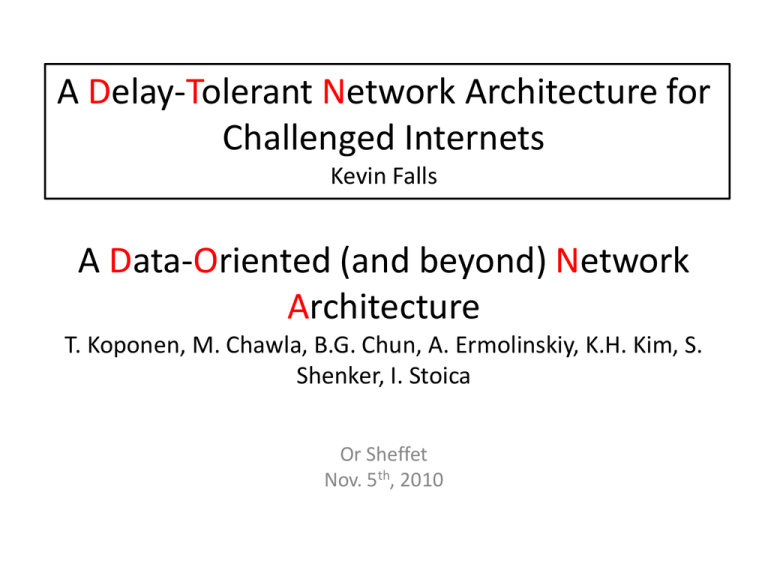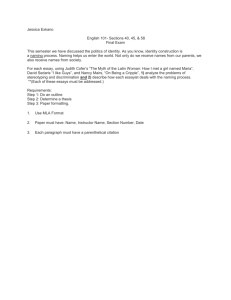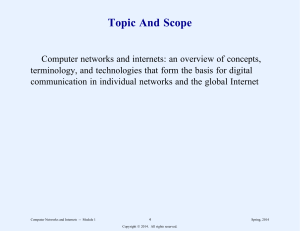A elay- olerant etwork Architecture for
advertisement

A Delay-Tolerant Network Architecture for
Challenged Internets
Kevin Falls
A Data-Oriented (and beyond) Network
Architecture
T. Koponen, M. Chawla, B.G. Chun, A. Ermolinskiy, K.H. Kim, S.
Shenker, I. Stoica
Or Sheffet
Nov. 5th, 2010
Appreciate Your Mailman!
Challenged Internets
•
•
•
•
•
Mobile
Exotic Media
Military
Sensor
…
• Approach 1:
“Fool internet protocols into believing
they are operating on a wellperforming physical infrastructure”.
• Approach 2:
Attach Challenged internets “at the
edge of the internet”.
Challenging Internets
•
High latency
–
•
Disconnection
–
•
Local scope, simple design
Authentication / access control on limited sources, particularly when we have multiple CoS
End nodes may be damaged
Life cycle < one-way delivery time!
Low Duty Cycle Operation
–
•
Storing a message for a long time.
Limited Longevity
–
–
•
Best-effort routing isn’t
suitable for these scenarios
Security
–
•
TCP/IP cannot work!
Interoperability
–
•
No end-to-end connection necessarily
Substantial queuing times
–
•
Transmission rates are small.
A-priori scheduling communication patterns
Low performance
–
Limited memory / processors
Approach 1: Fooling IP
• “Middle boxes”
• Performance Enhancing Proxies
– Fragile
– Violate fate-sharing
– Confound end-to-end diagnostics
• Protocol-boosters
– Specialized “internet to challenged-network” protocol
translation.
• Too specific:
– Can’t reuse for several applications
– Doesn’t use the “special resources the proxy node may have to
offer”.
Delay Tolerant Networking
1. Gateways.
–
–
–
–
–
Translation from one net to another.
“A point to enforce policy and control”.
Name mapping.
Custody transfer.
Store messages.
Delay Tolerant Networking
2.
Name Mapping
– Name:={Region, Entity}
– Region: Global. Connecting one DTN gateway to another.
– Entity: Local, hierarchical.
– Late binding for name resolution. (NOT prior to destiny resolution!)
3. Custody Transfer
– Persistent / Non-Persistent nodes.
– Persistent nodes store messages, participate in custody transfer:
Deliver responsibility for message arriving to destination!
Hop-by-hop reliability (NOT end-2-end!)
Violates fate-sharing!
– Might send “acknowledgements” to confirm delivery.
Delay Tolerant Networking
4.
Path Selection
–
5.
Cascading time-dependant ad-hoc contacts.
Convergence Layers and Retransmission
–
6.
Forwards bundles, using convergence layer (augmenting different transport-protocols if needed, to get “underlying
reliable delivery capability”+message boundaries).
Time Synchronization
–
–
7.
Requires synchronization, on a coarse level granularity
May help congestion control
Security
–
–
–
–
8.
Verifiable access to the challenged net. (Routers check credentials.)
Sender -> DTN -> DTN -> … -> DTN -> destination.
Discard traffic a.s.a.p
Cache keys for local senders + DTNs only.
Congestion/Flow Control
–
–
–
–
Flow: To next hop. Congestion: Message storage in a node.
Flow: Proactive (admission control) vs. reactive (direct flow control).
Control: Rejecting message upon full buffer; custody transfers; discarding non-custody
Approach: priority queue for custody storage.
•
•
Priority inversion
Head of line blocking
Discussion
• Agreement as to the general approach.
– Even if it does violate fate sharing.
• Implementation?
– Is it applicable?
• Architecture?
– What’s the underlying mechanism?
• Evaluation? Overhead issues.
– What are the good evaluations?
• Need we talk to all these networks?
– Most communication is internal…
• Analogy to mail incomplete: No supervising authority!
• Objections to the other approach:
– Does he push the specification “under the rug”?
– Does DTN uses the specialized resources?
A Delay-Tolerant Network Architecture for
Challenged Internets
Kevin Falls
A Data-Oriented (and beyond) Network
Architecture
T. Koponen, M. Chawla, B.G. Chun, A. Ermolinskiy, K.H. Kim, S.
Shenker, I. Stoica
DONA
• “We take a clean-slate look at naming”.
• “The user cares about content and is oblivious to
location”.
• Goal – same issues as in CCN:
– Persistence: Name should remain valid as long as data
is available.
– Availability: Seek (and get) nearby copies of data.
– Authenticity (NOT trust-worthiness): No spoofing!
• Major redesign of internet naming.
– Naming for Persistence and Authenticity,
– Name resolution for availability
DONA’s Basic Functionality
1.
Naming
– Flat
– Organized by principals. Each principal in charge of its own data naming.
– Composed of “P:L”
• P: hash of principal; L: label chosen by principal
– Convert human-readable names to DONA names.
2.
Name Resolution
– FIND(P:L) – Locate the data by name. Using a tree hierarchy of RHs.
– REGISTER(P:L) – Add a name to RHs w.r.t proximity to data.
• “On top of Basic” / Extensions:
– Improved content delivery: via caching, adding TTLs to FIND, avoiding
overloaded servers.
– DTNs: RH can be custody agents.
– Access rules + middleboxes: append FIND with authentication, imposing
firewall’s required authentication.
Discussion
• Preceding the CCN paper.
• Do discuss implementation, feasibility and
experimental results.
–
–
–
–
HTTP
Session Initiation Protocol
Large-files (P2P)
RSS
• “Every aspect of the design is (proudly) stolen
from elsewhere”.
• Is the “naming revolution” feasible?




